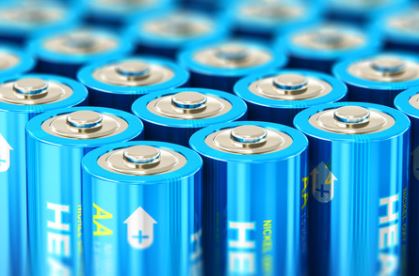Lithium-ion batteries (LIBs) are considered the most reliable energy storage system with high energy and power density. LIBs have already captured the electronics market and are used in cell phones, laptops, gadgets, etc., with long cycle life. However, the demand for LIBs is increasing rapidly especially towards electric vehicles (EVs) where high energy and power density are important factors. Since LIBs commercialization in 1991, graphite is being largely used as anode material which shows good cycling stability and high capacity. However, there is a need to improve the capacity and working voltage of cathode materials to boost the energy density of LIBs. The commercialized cathode materials such as layered LiCoO2, spinel LiMn2O4, and olivine LiFePO4 operates at average voltages of 3.8, 4.1, and 3.4 V [1]. Olivine type LiFePO4 has the advantage of the stable crystal structure, thermal stability, and low raw cost. All these features make LiFePO4 a competitive cathode material for LIBs.
![Scheme 1. Working mechanism of lithium-ion batteries with anode, cathode, and electrolyte. [1]](https://researchblog.nust.edu.pk/wp-content/uploads/2021/04/Scheme-1.-Working-mechanism-of-lithium-ion-batteries-with-anode-cathode-and-electrolyte.-1-300x211.jpg)
A research team lead by Dr. Ghulam Ali at U.S.-Pakistan Center for Advanced Studies in Energy, NUST, Pakistan in collaboration with South Korean Universities, .i.e. Dongguk University and Korea Institute of Science and Technology (KIST) have investigated a high voltage olivine type LiCoPO4 cathode material. LiCoPO4 was synthesized using a rapid single-step microwave assisted solvothermal route. The electrochemical properties of LiCoPO4 were evaluated using coin type lithium half cell. Interestingly, the LiCoPO4 cathode exhibits a discharge profile with an average potential of 4.7 V (Fig. 1a) which is far higher than already commercialized olivine-type LiFePO4. The high operating voltage of the LiCoPO4 cathode is attributed to the Co2+/Co3+ redox in the structure. Further, LiCoPO4 exhibits discharge capacities of 107 mAh g-1 at a rate of 0.1 C (167 mA g−1) during the 1st cycle and 80 mAh g-1 at the 50th cycle (Fig. 1b).
![Figure 1. (a) Charge-discharge profile and (b) cyclability of LiCoPO4 cathode in LIBs. [1].](https://researchblog.nust.edu.pk/wp-content/uploads/2021/04/Figure-1.-a-Charge-discharge-profile-and-b-cyclability-of-LiCoPO4-cathode-in-LIBs.-1.-1024x392.jpg)
In order to examine the LiCoPO4 cathode at elevated current densities, the rate capability test was performed in the voltage range of 3.5-5.2 V. The LiCoPO4 cathode exhibits discharge capacities of 106, 93, 71, and 50 mAh g−1 at 0.1, 0.2, 0.5, and 1.0 C rates, respectively. The LiCoPO4 cathode recovered discharged capacities of 87 and 97 mAh g−1 at rates of 0.2 and 0.1 C.
![Figure 2. Rate capability test of LiCoPO4 cathode in LIBs. [1]](https://researchblog.nust.edu.pk/wp-content/uploads/2021/04/Figure-2.-Rate-capability-test-of-LiCoPO4-cathode-in-LIBs.-1.jpg)
In this project, we also performed the full cell testing comprising LiCoPO4 cathode and MnCo2O4 anode. The selection of MnCo2O4 anode was made based on high capacity due to multiple redox in the material. The anode material is prepared using the solvothermal method followed by the calcination process to obtain the spinel phase. The lithium-ion battery was assembled using 1 M LiPF6 in the EC:DMC (3:7) electrolyte in the glove box. The capacities were normalized by adjusting the weight of the electrodes and the full cell delivered a discharge capacity of 95 mAh g−1 at a 0.1 C rate. The full lithium-ion cell delivers a reversible capacity of ~70 mAh g−1 at the 50th cycle with improved coulombic efficiency as shown in Figure 3a. The rate capability of LiCoPO4/MnCo2O4 full-cell (Figure 3b) was performed at rates of 0.1, 0.2, 0.5, and 1.0 C (167 mA g−1) where the cell delivers specific capacities of 97, 76, 53, and 30 mA g−1, respectively. The LiCoPO4/MnCo2O4 full-cell shows a working voltage of ~4.2 V and the specific energy of the cell was calculated to be 415 Wh kg−1 during initial cycles. The obtained energy density value for LiCoPO4/MnCo2O4 full-cell is reasonable compared to already commercialized LIBs. However, if exclude the 40% penalty factor, the calculated energy density of LiCoPO4/MnCo2O4 full-cell will be 249 Wh kg−1.
![Figure 3. (a) cyclability and (b) rate capability of lithium-ion full cell. [1].](https://researchblog.nust.edu.pk/wp-content/uploads/2021/04/Figure-3.-a-cyclability-and-b-rate-capability-of-lithium-ion-full-cell.-1.-1024x385.jpg)
These results suggest the suitability of the material, however, further improvements such as stability in cyclability and increase in capacity are needed to stabilize the energy density of the cathode. Our group is further investing the LiCoPO4 material by applying the coating and suitable doping for enhanced storage performance.
The outcomes of this project are as: 1) developed high voltage (4.7 V) and 2) high capacity (107 mAh g-1) LiCoPO4 cathode material, 3) with relatively stable cycling, and 4) testing of LiCoPO4 cathode materials in full lithium-ion cell.
The work done by Dr. Ghulam Ali was part of the international project titled “KIST School Partnership Project 2020” with aim to develop high voltage cathode materials for LIBs. We are working on this cathode material to further improve the performance and to probe the reaction mechanism using synchrotron based in-situ X-ray diffraction and X-ray absorption spectroscopy (XAS). NUST research team is actively working on the development of next-generation batteries such as solid state LIBs and sodium-ion batteries to fulfil the national and international energy requirements.
Acknowledgement
The author is thankful to KIST and Dr. Chung Kyung Yoon, Head/Principal Researcher at Center for Energy Storage Research, KIST for providing lab facilities such as in-situ XRD.
References
[1] M. Islam, M. Akbar, G. Ali, K.-W. Nam, K.Y. Chung, H.-G. Jung, A high voltage Li-ion full-cell battery with MnCo2O4/LiCoPO4 electrodes, Ceramics International, 46 (2020) 26147-26155. https://doi.org/10.1016/j.ceramint.2020.07.111
[2] Islam, M., Jeong, M. G., Ali, G., Oh, I. H., Chung, K. Y., Sun, Y. K., & Jung, H. G. (2018). A 4 V Li‐Ion Battery using All‐Spinel‐Based Electrodes. ChemSusChem, 11(13), 2165-2170. https://doi.org/10.1002/cssc.201800579
About Author
The author is an Assistant Professor at U.S.-Pakistan Center for Advanced Studies in Energy, (USPCAS-E), National University of Sciences and Technology (NUST) and can be reached at ali@uspcase.nust.edu.pk





